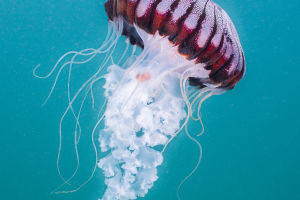The peacock, belonging to the pheasant family, is a stunning and unique bird that is widely revered as one of the most magnificent creatures on Earth.
Its resplendent plumage and captivating displays have made it a symbol of beauty and grandeur.
Peacocks are predominantly found in South and Southeast Asia, with India, Sri Lanka, Bangladesh, and Malaysia being their primary habitats.
The defining feature of peacocks is undoubtedly the extravagant plumage of the males. These magnificent birds possess long, vibrant tail feathers that unfold in a striking fan-like arrangement.
The feathers showcase an exquisite array of colors including shades of blue, green, gold, and copper, adorned with intricate patterns and mesmerizing eye spots. It is during courtship that male peacocks unveil this extraordinary spectacle to entice their female counterparts. In contrast, the females exhibit smaller frames and modest brown plumage, emphasizing their protective camouflage.
Not only renowned for their remarkable appearance, but peacocks also captivate with their distinctive calls. Male peacocks emit high-pitched hisses and melodious cries, creating a symphony in an attempt to catch the attention of female peafowls.
Peacocks are omnivorous creatures with a diverse diet. Their meals consist of insects, small reptiles, plant seeds, and fruits. These majestic birds often venture into open meadows and forested areas, foraging for sustenance amidst their natural habitats.
The resplendence and enigmatic qualities of peacocks have inspired countless works of art and literature, capturing the imagination of humanity throughout history.
In terms of their living habits, peacocks can be characterized as follows:
1. Habitat: Peacocks primarily inhabit forests, bushes, and open grasslands. They have a wide distribution and are predominantly found in South and Southeast Asia, including countries such as India, Sri Lanka, Bangladesh, and Malaysia.
2. Social Behavior: Peacocks exhibit social tendencies and often live in groups. During the breeding season, male peacocks establish territories and display their ornate tail feathers in elaborate courtship rituals, aiming to attract potential mates.
Female peacocks demonstrate a preference for males with the most exquisite plumage when selecting their partners.
3. Dietary Habits: As omnivorous creatures, peacocks consume a varied diet that consists of insects, small reptiles, plant seeds, and fruits. They employ their long and sharp beaks to capture and devour insects and other small invertebrates.
4. Breeding Behavior: The breeding season for peacocks typically aligns with the rainy season. Male peacocks engage in elaborate displays, showcasing their magnificent tail feathers and engaging in rhythmic movements to entice female peafowls.
Once courtship is successful, the female peacock constructs a nest on the ground and lays an average of 3-6 brown-colored eggs. The male peacock exhibits protective behavior towards the nest during the incubation period.
5. Vocalizations: Peacocks are known for their distinct vocalizations. Male peacocks emit resounding calls characterized by hissing sounds and high-pitched cries, primarily during courtship, to capture the attention of the females.
6. Migration: Peacocks generally exhibit a sedentary lifestyle, exploring their immediate vicinity in search of food and suitable breeding grounds. However, in some cases, due to environmental changes or limited resources, peacocks may engage in short-distance seasonal migrations.
These are general characteristics of the peacock's living habits, although specific behaviors and habits can vary among individuals and in response to environmental conditions.
The enchanting presence of peacocks continues to captivate and inspire admiration, making them a cherished component of the natural world.


